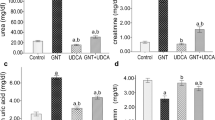Abstract
Different nitric oxide synthase (NOS) isoforms are found in the kidney. Some studies provided evidences that increased endothelial NOS (eNOS) activity leads to restoration of renal function after injury, but activation of inducible NOS (iNOS) aggravates renal failure. In the present study, the beneficial effects of selective iNOS blockade in gentamicin (GM) induced nephrotoxicity have been investigated. Four groups of rats were studied. Untreated control rats received saline. In GM group, GM was injected (IV, 4 mg kg−1). In GM + L-NAME group rats received L-NAME (N-omega-l-arginine methyl ester, a non-selective NOS inhibitor) simultaneously with GM (IV, 30 mg kg−1). Additional doses of L-NAME were administered 2 and 4 h after GM (IP, 30 mg kg−1). In GM + L-NIL group rats were treated by N-imino-ethyl lysine (L-NIL, a selective iNOS inhibitor). First dose (IV, 3 mg kg−1) administrated simultaneously with GM. Next doses (IP, 3 mg kg−1) were administered 2 and 4 h after GM. In all groups, serum and urine creatinine levels were measured. Creatinine clearance was calculated and considered as an estimation of glomerular filtration rate (GFR). Urine N-acetyl-b-d-glucose aminidase (NAG) activities were also determined. After experiments, kidney sections were histologically studied. Selective iNOS inhibition by L-NIL prevented the GM-induced decrease in GFR and increase in creatinine levels, while complete non-selective NOS inhibition by L-NAME aggravated the GFR reduction, elevation of creatinine levels and enzyme release (P < 0.05). Histological studies showed that GM-treated kidneys had evidences of tubular damages and these damages were less evident by the administration of L-NIL. In conclusion, selective inhibition of iNOS may prevent GM-induced nephrotoxicity, whereas non-selective inhibition of NOS aggravates it.




Similar content being viewed by others
References
Andre M, Latado H, Felley-Bosco E (2005) Inducible nitric oxide synthase-dependent stimulation of PKGI and phosphorilation of VASP in human embryonic kidney cells. Biochem Pharmacol 69:595–602
Cenk C, Sen S, Boztok N, Tuglular I (2000) Proctective effects of oral l-arginine administration on gentamicin induced renal failure in rats. Eur J Pharmacol 390:327–334
Cuzzocrea R, Mazzon E, Dugo L, Serraino I, Di Paola R, Britti D, De Sarro A, Pierpaoli S, Caputi A, Masini E, Salvemini D (2002) Eur J Pharmacol 450:67–76
Dehpour AR, Essalat M, Ala SH (1999) Increased by NO synthase inhibitor of lead-induced release of N-acetyl-b-d-glucosaminidase from perfused rat kidney. Toxicology 132:119–125
Gabbai FB (2001) Effects of nitric oxide synthesis blockers on renal function. Nephrol Dial Transplant suppl 1:10–13
Goligorsky MS, Gross SS (1997) Nitric oxide and the kidney. Chapman & Hall, New York, pp 22–38
Goligorsky MS, Budzikowski AS, Tsukahara H, Noiri E (2002) Co-operation between endothelin and nitric oxide in promoting endothelial cell migration and angiogenesis. Clin Exp Pharmacol Physiol 26:269–271
Herrera M, Garvin JL (2005) Recent advances in regulation of nitric oxide in the kidney. Hypertension 45:1062–1067
Holmqvist B, Olsson CF, Svensson ML, Svanborg C, Forsell J, Alm P (2005) Expression of nitric oxide synthase isoforms in the mouse kidney: cellular localization and influence by lipopolysaccharide and Toll-like receptor 4. J Mol Histol 36:499–516
Islas-Carbajal MC, Covarrubias A, Grijalva G, Alvarez-Rodriguez A, Armendariz-Borunda J, Rincon-Sanchez AR (2005) Nitric oxide synthases inhibition results in renal failure improvement in cirrhotic rats. Liver Int 25:131–140
Kielar ML, Jeyarajah DR, Zhou XJ, Lu CY (2003) Docosahexaenoic acid ameliorates murine ischemic acute renal failure and prevents increases in mRNA abundance for both TNF-alpha and inducible nitric oxide synthase. J Am Soc Nephrol. 14:389–396
Kone BC (2004) Nitric oxide synthesis in the kidney: isoforms, biosynthesis and functions in health. Semin Nephrol 24:299–315
Kumar U, Chen J, Sapoznikhov V, Canteros G, White BH, Sidhu A (2005) Overexpression of inducible nitric oxide synthase in the kidney of the spontaneously hypertensive rat. Clin Exp Hypertens 27:17–31
Rivas-Cabanero L, Montero A, Lopez Nova M (1994) Increased glomerular nitric oxide synthesis in gentamicin induced renal failure. Eur J Pharmacol 270:119–121
Rivas-Cabanero L, Rodriguez A, Arevalo M, Lopez-Novoa JM (1995) Effect of NG-nitro-l-arginine methyl ester on nephrotoxicity induced by gentamicin in rats. Nephron 71:203–207
Rivas-Cabanero L, Rodriguez A, Lopez Nova M, Martinez C (1997) Gentamicin treatment increases mesangial cell nitric oxide production. Exp Nephrol 5:23–30
Schwartz D, Brasowski E, Raskin Y, Schwartz IF, Wolman Y, Blum M, Blantz RC, Iaina A (2001) The outcome of non-selective vs. selective nitric oxide synthase inhibition in lipopolysaccharide treated rats. J Nephrol 14:110–114
Tolle M, Levkau B, Keul P, Brinkmann V, Giebing G, Schonfelder G, Schafers M, von Wnuck Lipinski K, Jankowski J, Jankowski V, Chun J, Zidek W, Van der Giet M (2005) Immunomodulator FTY720 Induces eNOS-dependent arterial vasodilatation via the lysophospholipid receptor S1P3. Circ Res 96:913–920
Valdivielso JM, Rivas Cabanero L, Morales AI, Arevalo M, Lopez-Novoa JM, Perez-Barriconal F (1999) Increased renalglomerular endothelin−1 release in gentamicin-induced nephrotoxicity. Int J Exp Pathol 80:265–270
Walker RJ, Duggin G (1988) Drug nephrotoxicity. Annu Rev Pharmacol Toxicol 28:331–345
Yamasowa H, Shimizu S, Inoue T, Takaoka M, Matsumura Y (2005) Endothelial nitric oxide contributes to the renal protective effects of ischemic preconditioning. J Pharmacol Exp Ther 312:153–159
Zhang F, Siow YL, O K (2004) Hyperhomocysteinemia activates NF-kappaB and inducible nitric oxide synthase in the kidney. Kidney Int 65:1327–1338
Author information
Authors and Affiliations
Corresponding author
Rights and permissions
About this article
Cite this article
Ghaznavi, R., Kadkhodaee, M. Comparative effects of selective and non-selective nitric oxide synthase inhibition in gentamicin-induced rat nephrotoxicity. Arch Toxicol 81, 453–457 (2007). https://doi.org/10.1007/s00204-006-0157-2
Received:
Accepted:
Published:
Issue Date:
DOI: https://doi.org/10.1007/s00204-006-0157-2




